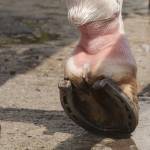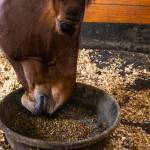Understanding Ringbone

Ringbone is a skeletal change that affects a horse’s lower limbs and can impact performance by causing lameness. This arthritic condition affects the pastern joint or occasionally the coffin joint. These are known respectively as high ringbone and low ringbone. Horses with high ringbone may have a good prognosis because the pastern joint is a low-motion joint. When the coffin joint is involved, the prognosis is much more guarded, as this is a high-motion joint.
The arthritic changes involved in the more common high ringbone can be seen as a bony enlargement around the pastern joint just above the coronary band at the top of the hoof. Though inflammation from arthritis can begin at any age, this ring usually can’t be seen or felt until the horse is 12 to 15 years old.
The cause of ringbone is joint wear and tear. Performance horses that repeatedly impact or stress the pastern joint and its surrounding soft tissues are at risk for ringbone. This includes jumpers and hunters, parade or carriage horses that work on hard surfaces, barrel racers and polo horses that create torque as they turn sharply, and even dressage horses that deeply flex their joints as they perform. Heavily built or overweight horses, especially those with unusually upright pasterns, are also prime candidates for ringbone because of the accumulated strain of increased concussive forces.
Ringbone usually causes lameness and can be diagnosed by lameness examination, radiographs, or MRI scans. While there is no cure for the condition, anti-inflammatory medications and resting the horse will allow the inflammation to decrease, lessening pain. Surgical fusion of the pastern joint can restore soundness in some horses with high ringbone. Regular trimming, therapeutic shoeing, and intra-articular or oral anti-inflammatories can also make the horse more comfortable.
Prevention of ringbone involves regular trimming and shoeing, avoiding overuse in disciplines that cause significant impact and strain, and using horses with upright conformation for light work rather than extreme performance.








